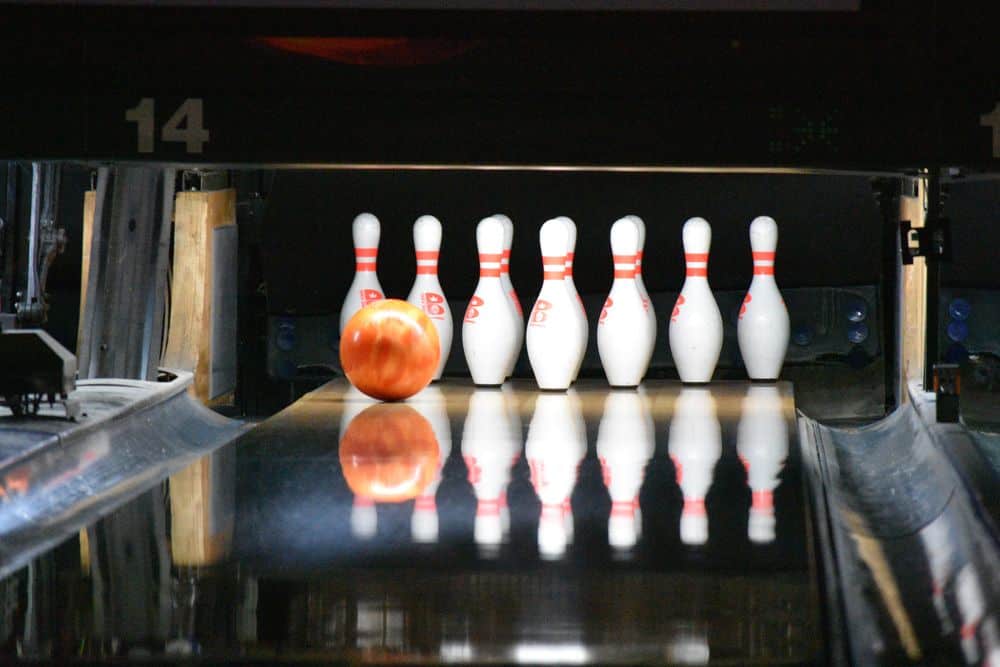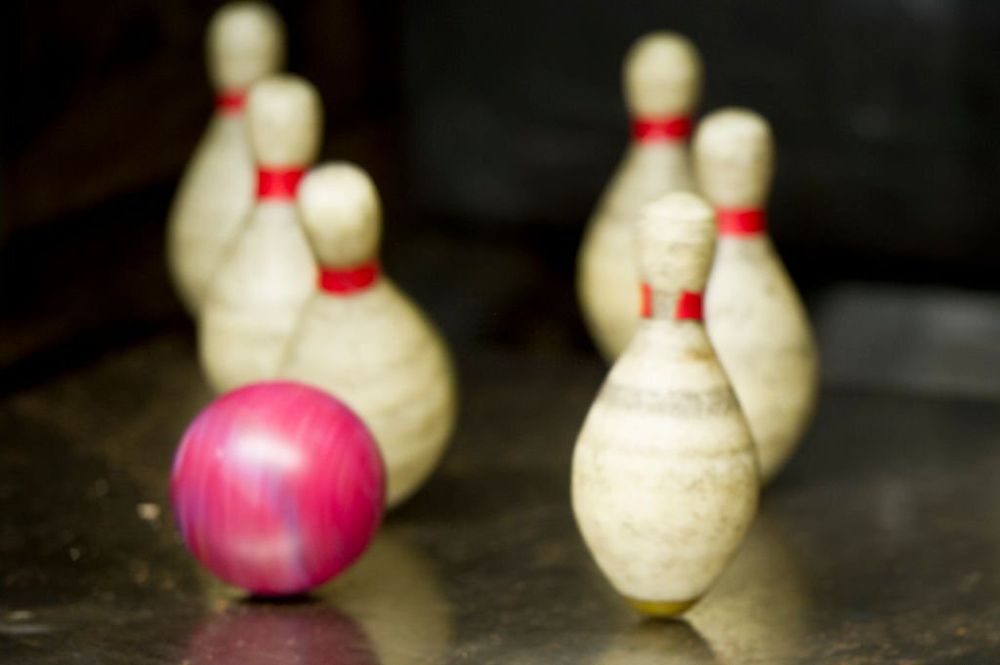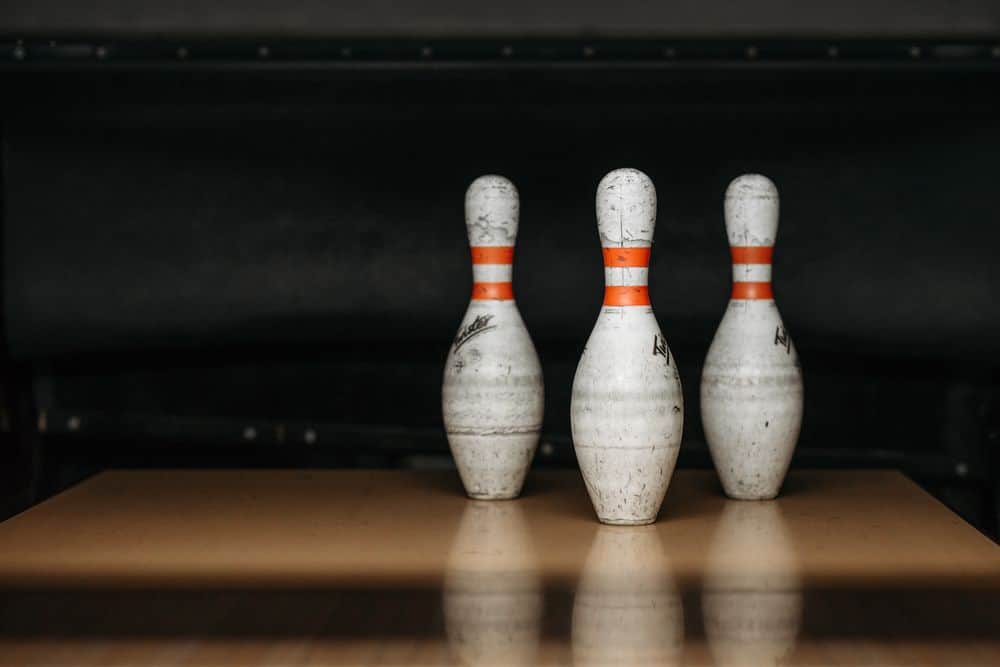Ever wondered how bowling pins are arranged? In this post, we’ll take a look at the different ways pins can be set up and how each one affects your game. Whether you’re a beginner or an experienced bowler, understanding the different pin placements is key to bowling well. So let’s dive in!
Things to Know About Bowling Pins
Before we start to learn more about how they are arranged, let’s first get to know bowling pins. Knowing more about them will help you to understand why they are arranged the way that they are often arranged and give you a deeper understanding of this amazing game.
Size of Bowling Pins
Bowlers use either ten-pin or nine-pin bowling. In ten-pin bowling, there are ten pins arranged in a triangular fashion and the bowler must knock down all of the pins in order to score points.
Nine-pin bowling is similar but with nine pins. In both variants, the size of the pins varies depending on the location. In the United States, pins used in regulation bowling are 17 inches tall and 2 3/4 inches wide at their widest point.
Weight of Bowling Pins
The weight of bowling pins is usually 10 pounds, but can vary depending on the league or tournament. Regulation pins are made from hard maple and are designed to stand up to the force of a bowling ball traveling at speeds of up to 15 miles per hour.
Material of Bowling Pins
Bowling pins are typically made of hard plastic or wood. They are designed to be durable and able to withstand the impact of a bowling ball. The pins are also color-coded, with each one having a specific color assigned to it. This helps to make sure that the pins are set up in the correct order for the game.
How Do Bowling Pins Get Their Shape?
Now that we know a little more about bowling pins, let’s take a look at how they get their shape. The shape of the bowling pin is designed to make it easier for the ball to knock them down.
The pins are tapered so that they are thinner at the top and bottom than they are in the middle. This allows the ball to strike the pins in the middle, which makes them more likely to topple over.
What Shape Do Pins Make When They are Set Up?
The most common way to set up pins is in a triangular formation. This is because the triangular shape of the pins makes it easier for the ball to strike them in the middle and topple them over.
The pins are also arranged so that they are all touching each other. This helps to keep them stable and makes it less likely that one pin will topple over without the others following.
There are other ways to set up pins, but the triangular formation is by far the most common. If you’re just starting out, it’s a good idea to start with this formation so that you can get used to hitting the pins in the middle and toppling them over.
As you become more experienced, you can experiment with other formations to see how they affect your game.
How Far are Bowling Pins Placed From One Another?
The distance between pins is regulated by the United States Bowling Congress (USBC). The USBC is the governing body for ten-pin and nine-pin bowling in the United States.
They have established guidelines for how close together pins can be placed. For regulation ten-pin bowling, the pins must be placed 60 feet from the foul line to the center of the pin deck. This means that the pins are arranged in a triangular formation with each side of the triangle measuring 60 feet.
For nine-pin bowling, the USBC has established a minimum pin spacing of 30 inches. This is to ensure that the ball has enough room to strike the pins without hitting another pin.
There is no maximum pin spacing for nine-pin bowling, so the pins can be placed as close together as the alley owner desires.
Arrangement of Bowling Pins
The arrangement of bowling pins is regulated by the United States Bowling Congress (USBC). The USBC is the governing body for ten-pin and nine-pin bowling in the United States. They have established guidelines for how the pins must be arranged.
For regulation ten-pin bowling, the pins must be arranged in a triangular formation with each side of the triangle measuring 60 feet. This means that the pins are placed 60 feet from the foul line to the center of the pin deck.
For nine-pin bowling, the USBC has established a minimum pin spacing of 30 inches. This is to ensure that the ball has enough room to strike the pins without hitting another pin.
There is no maximum pin spacing for nine-pin bowling, so the pins can be placed as close together as the alley owner desires.
The arrangement of the pins is important because it affects the game. If the pins are not arranged correctly, it can be difficult for the ball to strike them in the middle and topple them over.
The USBC has established guidelines to ensure that the pins are arranged in a way that is fair and makes the game more enjoyable.
How Are Pins in Bowling Numbered?
The pins in bowling are numbered from 1 to 10. The numbering of the pins is important because it helps bowlers keep track of which pins they have knocked down.
The number also corresponds to the score that the bowler will receive for knocking down that pin. For example, if a bowler knocks down the 1-pin, they will receive 10 points. If they knock down the 2-pin, they will receive 9 points, and so on.
The numbering of the pins also helps to determine which pins are considered “dead wood”. Dead wood is any pin that is not parallel to the foul line.
This can happen if a pin is knocked down but not completely toppled over, or if a pin is moved by another pin that is knocked down. Pins that are not completely toppled over are still considered live pins and can be knocked down for points.
How to Set up Bowling Pins
Setting up bowling pins is simple. First, find the foul line and mark it with a piece of tape or chalk.
Then, set up the pins in a triangular formation with the 1-pin in the front and the 2-pin and 3-pin behind it.
The 4-pin and 5-pin should be behind the 3-pin, and the 6-pin, 7-pin, 8-pin, and 9-pin should be behind the 5-pin. The 10-pin should be in the back of the formation. Once all the pins are in place, you are ready to bowl!
When setting up bowling pins, it is important to make sure that they are all in a straight line. This will help ensure that the ball rolls down the lane in a straight line and does not veer off to one side. It is also important to make sure that the pins are spaced evenly apart.
The USBC has established minimum spacing requirements for ten-pin and nine-pin bowling, but you can space the pins however you like as long as they are all evenly spaced.
Knowing the Distances
The distance from the foul line to the center of the pin deck is 60 feet for regulation ten-pin bowling.
This is the same distance for nine-pin bowling, but there is no maximum pin spacing, so the pins can be placed as close together as the alley owner desires.
The distance from the foul line to the 1-pin is also 60 feet. This is the same distance for all of the other pins. The only exception is the 10-pin, which is located in the back row of the pin deck. The 10-pin is located 12 inches behind the 1-pin.
This allows for a margin of error when bowling, as it is more difficult to hit the 10-pin in the back row.
Placing the Bowling Pins According to Numbers
When setting up the pins, it is important to place the 1-pin in the front and the 2-pin and 3-pin behind it.
The 4-pin and 5-pin should be behind the 3-pin, and the 6-pin, 7-pin, 8-pin, and 9-pin should be behind the 5-pin. The 10-pin should be in the back of the formation. This will ensure that the pins are arranged in a way that is fair and makes the game more enjoyable.
How Does Pin Placement Affect Bowling?
The placement of the pins can affect bowling in a number of ways. First, if the pins are not arranged correctly, it can be difficult for the ball to strike them in the middle and topple them over.
This can result in pins that are only partially knocked down or bounced off to the side.
Second, if the pins are not spaced evenly, it can be difficult for the ball to strike them all at once. This can result in pins that are not knocked down or only partially knocked down.
Finally, if the pins are not placed in a straight line, it can be difficult for the ball to roll down the lane in a straight line. This can result in the ball veering off to one side and missing the pins entirely.
What is the First Pin in Bowling Called?
The first pin in bowling is called the 1-pin. This is the only pin that is located in the front row of the pin deck. The 1-pin is located 60 feet from the foul line and 12 inches from the left side of the lane.
The 1-pin is also known as the head pin or the king pin. This is because it is the most important pin in bowling. Hitting the 1-pin in the middle could result in a strike, which is the best possible score in bowling.
What is Each Bowling Pin Called?
Each bowling pin is assigned a number. The 1-pin is in the front and is called the head pin or king pin.
The 2-pin and 3-pin are behind the 1-pin, and the 4-pin and 5-pin are behind the 3-pin. The 6-pin, 7-pin, 8-pin, and 9-pin are behind the 5-pin, and the 10-pin is in the back.
Let’s Recap
When setting up bowling pins, it is important to:
– Make sure that the pins are in a straight line
– Make sure that the pins are spaced evenly apart
– Make sure that all distances are according to regulation
If you follow these tips, you should have a successful game of bowling. Now that you know everything you need to know about bowling pins, you can start bowling!









